

 United States of America/Canada/Kingdom of the Netherlands (1963)
United States of America/Canada/Kingdom of the Netherlands (1963)
Reconnaissance Vehicle – 424 Built
The 113-and-a-half
By 1963, the US army had adopted Cadillac’s M114 to serve as a command and reconnaissance vehicle. However, the vehicle had proven troublesome and it elicited no interest from abroad for any export. Seizing this opportunity, the FMC Corporation (nowadays United Defense LP), prepared a reconnaissance and command vehicle of their own. FMC had also designed the world famous M113 APC, and used it as a basis for the new AFV.
The result was the M113 ½, which shared many features with it’s bigger brother. The Netherlands and Canada bought almost four-hundred in total, and some of them still serve to this day. They served with reconnaissance units and as command vehicles, being fast and with good cross-country mobility.
| Hello dear reader! This article is in need of some care and attention and may contain errors or inaccuracies. If you spot anything out of place, please let us know! |
General design of the M113 ½
While similar in appearance to the original M113, the new vehicle was modified heavily for its new purpose. The troop compartment was completely removed. The same 6 cylinder General Motors engine which was on the M113 was placed at the rear. The crew compartment was at the front of the vehicle, and housed the driver, the commander and the observer. It was described as cramped. While the suspension from the M113 was kept, one roadwheel was eliminated, leaving only four on each side.

A Dutch M113 C&V with the Oerlikon turret – Photo: Ulrich Wrede, as taken from Panzerbaer
The aluminum armor was also taken from the M113, with a maximum thickness of 1.75 in (44.5 mm) on the lower front part, and a minimum of 0.75 in (19 mm). While these thicknesses may seem large, aluminum does not offer the same level of protection as steel. The armor could only protect the crew from machine-gun fire and shrapnel. An easy way to differentiate the M113 ½ from the M114 is that the front of the former is 3-sided, while that of the latter is a simple slope.
The Lynx was narrower (2.4 m vs 2.68 m), shorter (4.6 vs 4.86 m) and significantly lower (2.17 vs 2.52 m) than the M113. Of course, this also meant that the vehicle was lighter (8700 vs 11,300 kg). It retained the amphibious capabilities of its forerunner, but necessitated some quick preparations. A trim vane had to be erected (a part at the front which kept water from coming over the vehicle), bilge pumps started (remove water from inside the vehicle) and some covers put in place. Once in the water, the vehicle was propelled by the movement of its tracks, being able to reach a modest 6 km/h (4 mph).
Also, being significantly lighter, the 6 cylinder 212 hp diesel engine allowed it to reach speeds of up to 71 km/h (44 mph). The range, when going only on roads, was above 500 km (325 mi).
The Dutch M113 C&V
The Netherlands was the first customer for the new vehicle, buying 250 vehicles. In Dutch service, these were known as the M113 C&V (Commando & Verkenningen, literally Command & Reconnaissance). Sometimes, they are also called C&R. The driver was seated in the front left of the vehicle, with an infrared periscope mounted on his hatch and four normal ones on the roof of the vehicle. To his right sat the radio-operator, who also had four periscopes at his disposal. The commander was seated at the back, under a large cupola.
A 12.7 mm (0.5 in) M2TTHB machine-gun was mounted on top of the vehicle, being operated by the commander. Another 7.62 mm (0.3 in) machine-gun could be mounted in front of the radio-operator’s hatch.
However, in 1974, the Dutch army decided to replace the commander’s cupola and armament with an Oerlikon Contraves GBD-AOA turret, armed with a 25 mm (0.98 in) KBA-B cannon. The C&V was eventually replaced by the Fennek.
Some of the Dutch vehicles have been sold off to Bahrain (35) and Chile (8).
The Canadian Lynx
Canada was the second operator of the type, having bought some 174 vehicles in 1968. The Canadian vehicles differed in the arrangement of the crew. The driver takes the same position, but the radio operator is placed at his back. The commander sat on the right side of the vehicle, with the same M26 cupola. He operated the 12.7 mm heavy machine-gun, and could fire it from inside the vehicle. However, reloading had to be done externally.
The Canadian Lynx were removed from service in 1993, replaced by M113A2s which had been stationed in Germany and returned after the fall of the Soviet bloc and AVGP Cougars. In 1997, the role was taken over by the Coyote vehicles. Most Lynxes were scrapped or became range targets. A fair few are spread in museums all over Canada.
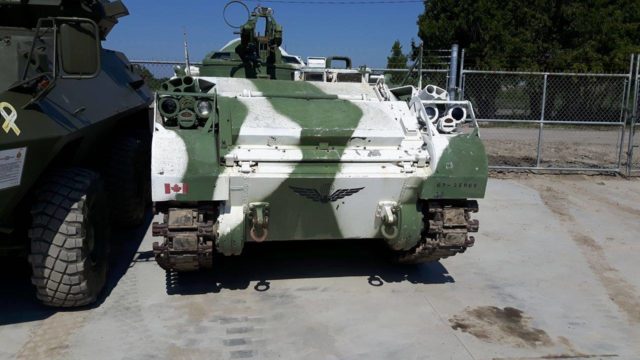
A Canadian M113 Lynx at the Ontario Regiment Museum – Photo: Samuel Richardson, private communication
Links & Sources
On Army-Guide
Specification sheet on AFV Database
Photos in Bahraini service
Thanks to Anthony Sewards for the information he provided
M113 Lynx specifications |
|
| Dimensions | 4.6 x 2.4 x 2.17 m (15’1” x 7’9” x 7’1”) |
| Total weight, battle ready | 8460 kg (18,650 lbs) |
| Crew | 3 (driver, comander, radio-operator) |
| Propulsion | General Motors 6V53, 6 cylinder, 212 hp |
| Suspension | Torsion bar |
| Speed (road) | 74 km/h (44 mph) |
| Range | 520 km (325 mi) |
| Armament | 0.5 in (12.7 mm) M2TTHB machine-gun |
| Armor | Aluminum, 19-45 mm (0.75-1.75 in) |
| Total production | 424 |
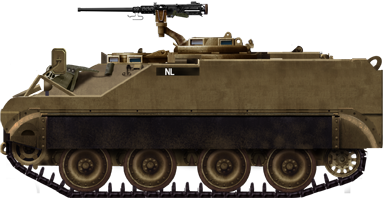
A Dutch M113 C&V, before the addition of the Oerlikon turret.
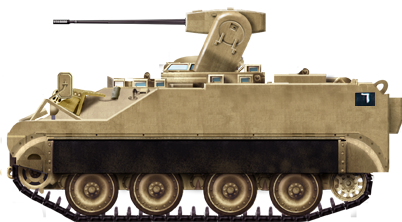
A Bahraini M113 C&V, with the 25 mm turret, during Exercise Peninsula Shield 9. Bahrain bought 35 vehicles from the Netherlands.
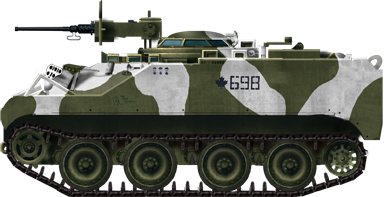
A M113 Lynx from the Ontario Regiment Museum.
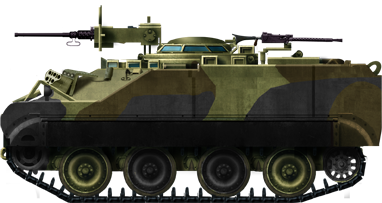
Canadian Lynx recce armored vehicle in the 1970s.
Gallery
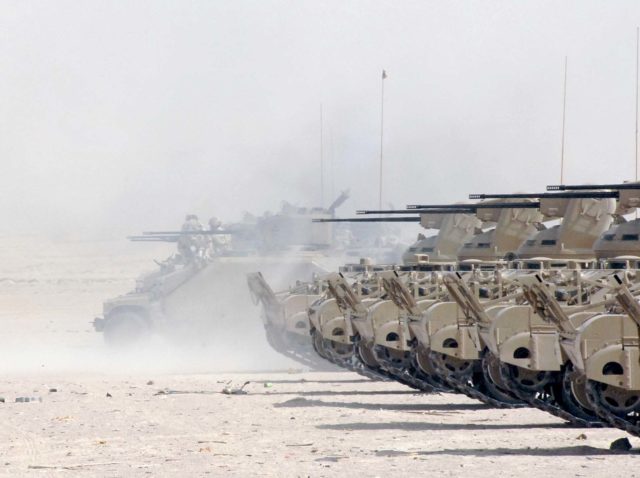
Bahraini M113 C&Vs on a shooting range during Peninsula Shield 9 – Photo: Bahrain News Agency, as taken from the MilinME blog
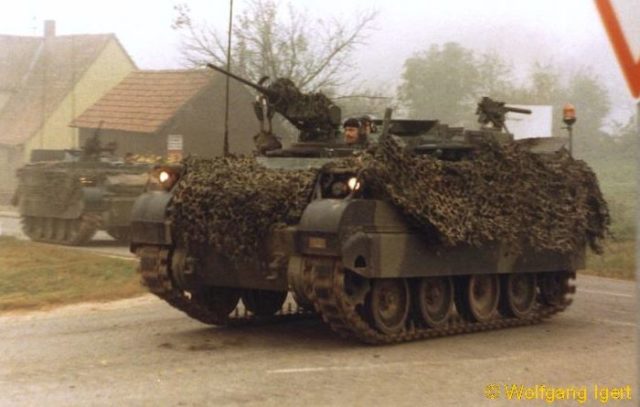
Canadian M113 Lynx of the 4th Mechanized Brigade, 1986 – Photo: Wolfgang Igert, as taken from Panzerbaer
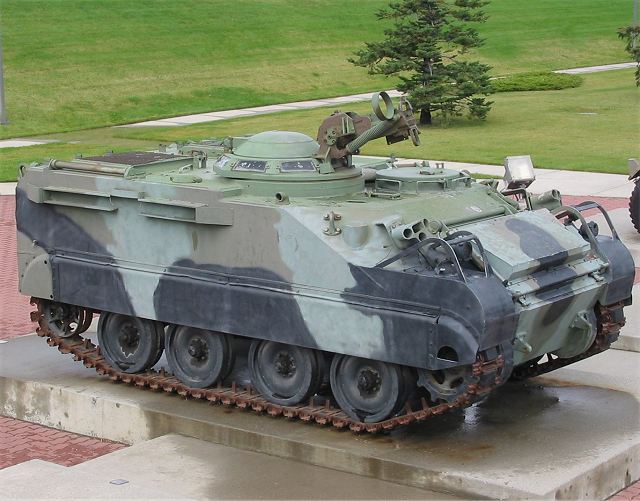
A Canadian Lynx used as a monument – Photo: Taken from Army Recognition

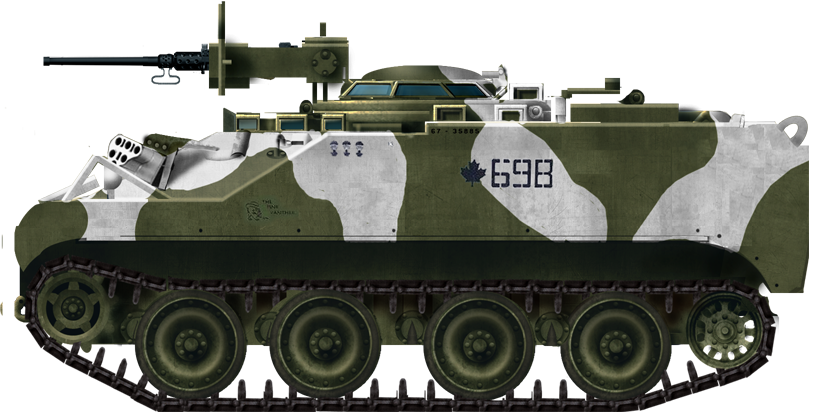
31 replies on “M113½ C/V Lynx”
The Canadian Lynx was taken out of service in 1993, replaced in the intern by surplus M113A2’s that returned from Germany and the AVGP Cougar, until 1997 when the LAV-RECCE Coyote came into service. The Lynx’s were scraped , some became range targets, museum display’s or sold off.
Please note that the Lynx identified above as circa 1970’s is equipped with a rear-facing MAG58 medium machinegun which came into service around 1986. The actual service date for this picture should be late 1980’s to 1993 when Lynx was removed from service. For reference see the picture of the Lynx noted as 4CMBG 1986 has the correct Browning GPMG in the rearward position for the period.
I would suggest that that IS a M1919A1 with the detachable shoulder stock that we had back in the 70’s. We never used it on a Lynx to my knowledge!
I fired it all the time. It was a range qualification on my crewman 011 course. I spent two years in 8CH Recce Squadron, and it was always mounted on the vehicle for any exercise- in Petawawa, Germany, and Calgary. The observer ‘s position was he’ll- your knees banged on the engine firewall, and the exhaust blew in your face most of the time. Most observers stood on the seat and faced forward. There was never enough room for the kit,personal or vehicle, and I didn’t know how we were ever going to store the stated ammo load of we ever had to. Top speed was around 35 mph, and German Lucy’s crews laughed at us. An inadequate vehicle that the Canadian government wanted to replace tanks with in the 1970’s-because it had tracks, and the Ottawa experts demanded a study be conducted.
Hi Tony. There is a good Lynx outside 7CFSD and one at the crossroads by Edmonton garrison, just in case you missed them on your list of surviving vehicles.
We weren’t even issued the shoulder stock for the GPMG. That was an infantry thing.
Don
The shoulder stock for the GPMG was issued to Armour Lynx crews; but they were few and not all crews had one.
Nope the stocks (that we never used), were part of the E.I.S. for each vehicle. They usually ended up in a locker, unless there was a G.O.C.’s inspection.
The C-6 however did come with kit that the infantry didn’t get but as we had them in the RCD’s for years before they were officially issued to the rest of the Forces, it’s not surprising.
In the Strathcona’s we were all issued the shoulder stock, it was usually left in the locker at the hanger on exercise but was used on the range for stability.
If you look closely at the picture you will see that the C5 machinegun is fitted with the optional butt attachment. The picture is correct for the era. I crewed these from 1985 – 1993.
Ian
I think if you look closer you will notice that the GPMG in the “circa 1870s” is a M1919/C1/C5A1 GPMG sporting the shoulder stock, which gives it a bit of an odd look. The C1/C5A1 spanned the entire Canadian service life of the Lynx C&R.
“The same 6 cylinder General Motors engine which was on the M113 was placed at the rear. The crew compartment was at the front of the vehicle….” Looking at the external pictures of this vehicle I have to wonder where the transfer case is located and how the drive shaft connects with the final drives. It must have REALLY been cramped- especially when compared with the conventional M113- with a rear mounted engine and front drive sprockets.
Bruce: I suspect you are mixing up the transfer case with the steering control differential. The transfer case is the coupling gearbox that runs from the back of the engine across to the front of the transmission.
The power pack in the rear sits in the same directions as the powerpack of a M113. Where a M113 has a short driveshaft from the transmission to the steering control differential, the Lynx has a long driveshaft that runs the distance from the rear mounted pack to the differential that is in the same location as a M113 (at the front). There are tunnel covers running through the crew compartment that prevent injury to the crew from the spinning driveshaft.
As with any armoured recce vehicle, space is a bit of a premium. If there was too much space, then the designers would have just made the vehicle smaller….the idea of a recce vehicle is to limit the size as much as reasonable. All in all, the lynx is not bad for crew area, especially compared to the ferret scout cars that it replaced.
Typical for the Dutch M113 C&V is the hinged entry hatch for the gunner a bit aft of the middle, at the right hand side of the vehicle. Visible on the photo by Ulrich Wrede in the article above.
The position of the crew members in the Dutch M113 C&V is always been, driver: left forward, commander: right forward, gunner: center .50″ cupola, later 25mm turret. All crew members could act as radio operator, the commander was the main operator.
Before the modification to the 25mm gun, the commander also operated the mounted 7.62mm machine gun in front of him.
The C&V was also used by the Koninklijke Marechaussee (Royal Dutch Military Police), they were replaced by M113A1’s when the C&V’s received the 25mm Oerlikon gun.
Another point that distinguishes the C&V (with .50″) from the Lynx are the openings in the sides of the fuselage above the drive sprocket, these holes were necessary to reduce buoyancy of the fuselage to prevent a ” nose up” position in the water that was caused by the placement of the .50″ cupola in the middle of the vehicle.
During the modification these holes were closed again to increase the buoyancy of the fuselage to cope with the higher weight of the 25mm turret. This closure is to be seen on the photo by Ulrich Wrede in the article above. At the same time “air boxes” were mounted on the rear of the fuselage, also to increase buoyancy. These boxes can be seen on the 2nd drawing from the top of the article above.
Another significant change during the modification was the rebuilding of the driver’s- and commander’s hatches from hinged, to lift and turn sideways types.
The Canadian version (and I believe the Dutch also), was designated as ‘M114’, not M113, or M113 1/2. I’m positive re the Canadian one, having lived on one for three years in the late 1970’s.
“i drove one for three years” is not certification as an expert.
Never M114 or M113 1/2 it was simply M113 C&R Lynx. I crewed one from 1985 until they were replaced.
I crewed one from 1985-1993, driver for a year then after CLC and Patrol Cmdr Crse, I was a Crew Commander in 1986. I was also Advanced D&M qualified. The vehicle was never named M114 it was always M113 C&R. Some people called it M113 !/2 but this was never an official designation.
Negative, both the Canadian Lynx as the Dutch C&V are called M113, the M114 is a (totally) different vehicle…
https://en.wikipedia.org/wiki/M114_armored_fighting_vehicle
You would be wrong Eric. Did you notice the part where I stated I lived in one for three years? The ‘M113 1/2 C+R’ designation only applied to the prototype vehicles made by FMC, it didn’t apply to any of the production versions. Both the Canadian and Netherlands ones were designated ‘M114 (Export)’.
Relying on Wikipedia as a sole source of facts is often not the best idea. In this case, while the Wiki page for the Cadillac M114 might be correct, that doesn’t make my statement incorrect, which it is not, according to the relevant American, Canadian and Netherlands official documentation on the vehicle in question.
22C. You are incorrect.
Mr. Boot is correct.
There was not an M number associated with the Lynx. Although heavily related to the M113, there are only quasi official references to the term M113-1/2. It can be found on things like messages or the pamphloet on cam and concealment, but on all official documentation like modification instructions, or parts and maintenance manuals, the term Lynx C&R is used. We have a couple at work, and I checked the data plates to see what was on there, and again, just lynx C&R.
OK Rob, clear for the Lynx then, all Dutch documentation speaks about M113 C&V the “Here’s How (operation and maintenance for M113A1-M106E1)” manuals from FMC corporation were part of the delivery.
Looking in “M113 in action” (squadron/signals publications ARMOR NO.17) I think I see were I went wrong, the Dutch M113 C&V is equal to the M113 C&R, the Lynx is an altered version of the C&R, not the other way around.
There was a good discussion about the names on MLU here which includes photos of the Canadian data plates: http://www.mapleleafup.net/forums/showthread.php?t=25008
In the Canadian Armed Forces the the vehicle was referred to as the “M114 Lynx”, both verbally and in print. Just as the M113A1 was referred to as an “M113”. We most certainly did include the ‘M’ in regards to the Lynx. There are also no fractional numbers used for American military vehicle nomenclature. That was strictly an FMC number for the prototype.
In American documentation the American designation for both the Canadian and Netherlands versions were “M114 (Export).” The designation is based on more than the body shape. When facts and theory don’t conform to each other, the facts win, every time 😉
You are mistaken.
The only advocate for your mistaken assertion seems to be you. The M114 was an entirely different vehicle.I worked in these things as well, over twenty years, and you are the only person that I have ever heard of that called a Lynx an M114
The last time I saw a 114, it was sunk in a pond that we used for swimming 113’s and Lynx. The Engineers used it for diver training.
Anyone know where I can find a copy of CFP 305 (8) ?
Armour School Precis 115 Lynx Chassis is drawn from it.
PS. 22C, as a person who has worked on the Lynx for several years during my service, the Lynx has a M 113 C&R designation. The M 114 was a completely different vehicle and did not see service for any length of time in the US Armed Services. Most became Hard Targets on the Ranges. Canada never purchased M 114s.
https://www.militaryfactory.com/armor/detail.php?armor_id=108
There actually was An M114 in CFB Calgary for a while, in the Strathcona compound by the butler hut. Story goes that some guy attempted to import it, had it seized, and CBSA gave it to us. After some head scratching, it disappeared, as we certainly couldn’t use it. Don’t know what happened to it after 1992.